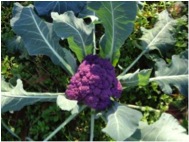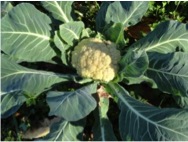

- Starting the Plants from Seeds
- Planting
- Soil Requirements and Fertility
- Weed Control
- Irrigation
- Harvest
- Varieties
- Insect and Disease Problems
Cauliflower is a cool season vegetable that belongs to the Brassicaceae family, and is sometimes considered one of the more difficult vegetables to grow in the home garden. For those gardeners who have a little patience, cauliflower can be an interesting and rewarding crop to grow. Gardeners can now select varieties of cauliflower that range in color from the traditional white to a deep purple.
Starting the Plants from Seeds
For a late spring harvest, start seeds indoors or in a cold frame or greenhouse at the beginning of February (four to six weeks before you want to move them outside). Harden the seedlings before planting them in the ground in March by leaving them outside for a few hours every day for three days. Leave them overnight on the third day. For a fall harvest, start seeds indoors at the end of July. They can then be planted in the garden the last week of August. Garden centers are also a source for purchasing both spring and fall transplants. Purchase the transplants a few days before planting to ensure they are fresh and healthy. Using healthy transplants can make growing cauliflower a more likely success.
Planting
Locate the garden in an area that will have at least six to eight hours of sunlight per day. Till the bed to a depth of 6 to 10 inches, incorporating 4 inches of good organic matter into the mix. Remove any sticks and stones. Smooth the soil with a rake and plant seedlings 18 to 24 inches apart in rows with 24 inches between rows.
Soil Requirements and Fertility
Cauliflower prefers rich, well-amended garden soils. Heavy sand or clay soils should be amended with organic matter to successfully grow cauliflower. Use a soil test to determine the pH and fertility needs of the soil. The soil pH should be between 6.5 and 6.8. In the absence of a soil test, incorporate 3 to 4 pounds of 5-10-15 fertilizer or equivalent per 100 square feet of garden area. After initial fertilization at planting time, apply 2 pounds of additional 5-10-15 fertilizer per 100 square feet of bed each month during the growing season.
Weed Control
Mulch cauliflower beds with pine straw, shredded leaves or other material to help preserve moisture and control weeds. Herbicides are available for weed control but should be used only when necessary.
Irrigation
Water seedlings well immediately after planting. Water daily for the first week to help get the crop established. Continue to irrigate cauliflower every four to five days as needed to keep the plants healthy. Drip irrigation or soaker hoses are the preferred method of irrigation because they conserve moisture and keep the foliage dry.
Harvest
Harvest the heads when they are 6 to 8 inches in diameter. Cut the head at the base using a sharp knife. Cauliflower should be eaten soon after harvest for best flavor and the highest amount of nutrients. Cauliflower can be stored in the refrigerator for a week or more by placing it in a plastic bag. Cauliflower can also be frozen for long-term storage.
Varieties
Most of the white head varieties need to be blanched while growing for the best white color and flavor. To blanch the heads, tie a layer of leaves around the cauliflower head with a rubber band when the head is about the size of a baseball (about 4 inches in diameter). Some self-blanching varieties? leaves grow naturally around the head on their own, preserving the whiteness and the flavor.
'Snow crown' - 50 days to harvest. Must be tied for best quality. Heads are 7 to 8 inches in diameter, rounded.
'Imperial' - 60 days to harvest. Must be tied to produce the white head.
'Cheddar' ? 68 days to harvest. Yellow head. For maximum color intensity, do not tie the head.
'Amazing' ? 75 days to harvest. Dense head; thick leaves are easy to tie for the best results.
'Graffiti' - 80 days to harvest. Intensely purple head. Leaves are dark green and do not need to be tied.
Insect and Disease Problems
Insects and diseases can sometimes become a problem because of the slow-growing nature of cauliflower. Cabbage worms, cutworms, cabbage root maggots, flea beetles, aphids, slugs and snails can prevent you from growing healthy cauliflower. Diseases can include Downy mildew, Alternaria leaf spot, Black rot and a few others. Both insects and diseases can be controlled by using sound garden practices and spraying with organic or synthetic chemicals only when necessary. Contact your local Cooperative Extension office for correct diagnosis and control recommendations.
Status and Revision History
Published on Aug 07, 2012
Published with Full Review on Mar 28, 2017
Published with Full Review on Jun 21, 2022


























































